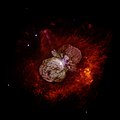tangan:Eta Carinae.jpg

pataayaway miazih hacica ku tabaki: 600 × 599 syangsu. u zuma katingalaw: 240 × 240 syangsu | 480 × 480 syangsu | 769 × 768 syangsu | 1,025 × 1,024 syangsu | 2,015 × 2,013 syangsu.
saayaway a tangan (2,015 × 2,013 syangsu, hacica ku tabaki nu tangan: 163 KB, MIME kakuniza: image/jpeg)
tangan nu nazipa’an
sapecec ku demiad/tuki sapiciwsace ku tuki nina demiad a tangan baziyong
| demiad/tuki | sukep tu zunga | ditek | misaungayay | pacunus sakacaay kapawan | |
|---|---|---|---|---|---|
| ayza | 2017年12月18日 (sakacacay a demied nu lipay) 17:41 |  | 2,015 × 2,013(163 KB) | The NMI User | Reverted to version as of 14:14, 1 May 2008 (UTC) |
| 2017年3月13日 (sakacacay a demied nu lipay) 22:45 |  | 3,000 × 2,998(1.18 MB) | Leogorgon | larger file size | |
| 2008年5月1日 (sakasepat a demied nu lipay) 22:14 |  | 2,015 × 2,013(163 KB) | Vol de nuit | {{Information |Description=(NASA News Release) A huge, billowing pair of gas and dust clouds are captured in this stunning NASA Hubble Space Telescope image of the supermassive star Eta Carinae. Using a combination of image processing techniques (ditheri |
sakapaluwaluway nu tangan
nayi’ ku kasabelih masasiket katukuh tini a tangan.
sahamin-subal tangan pisaungay zasatu
isasa’ zuma Wiki masaungay tina tangan:
- da.wikipedia.org ku pisaungay kalitemuhan kawaw
- en.wikipedia.org ku pisaungay kalitemuhan kawaw
- Star
- Eta Carinae
- Wikipedia:Selected anniversaries/March 11
- Wikipedia:Today's featured article/March 2017
- Wikipedia:WikiProject Wikipack Africa Content/Wikipedia:Showcase
- Wikipedia:WikiProject WikiFundi Content/Eta Carinae
- Wikipedia:Today's featured article/requests/Eta Carinae
- Wikipedia:Today's featured article/March 12, 2017
- Wikipedia:Main Page history/2017 March 12
- Wikipedia:WikiProject WikiFundi Content/Wikipedia:Showcase
- Wikipedia:Main Page history/2022 March 11
- Wikipedia:Main Page history/2022 March 11b
- Wikipedia:Main Page history/2023 March 11
- Wikipedia:Main Page history/2023 March 11b
- User:2003 LN6/sandbox/Eta Carinae variable
- List of luminous blue variable stars
- en.wikiversity.org ku pisaungay kalitemuhan kawaw
- User:Marshallsumter/Radiation astronomy2/Visuals
- User:Marshallsumter/Radiation astronomy2/Violets
- Stars/Astronomy
- User:Marshallsumter/Radiation astronomy2/Violets/Quiz
- Stars/Sun/Astronomy/Quiz
- User:Marshallsumter/Radiation astronomy/Courses/Principles/Hourly 2
- User:Marshallsumter/Radiation astronomy/Courses/Principles/Final quiz
- Draft:Original research/Io/Quiz
- Titan/Quiz
- Stars/Solar systems/Quiz
- Moon/Quiz
- Earth/Quiz
- User:Marshallsumter/Radiation astronomy/Colors/Quiz
- Volcanoes/Io/Quiz
- Stars/Violets
- User:Marshallsumter/Radiation astronomy2/Stars
- Stars/Violets/Quiz
- es.wikipedia.org ku pisaungay kalitemuhan kawaw
- fr.wikipedia.org ku pisaungay kalitemuhan kawaw
- hi.wikipedia.org ku pisaungay kalitemuhan kawaw
- it.wikibooks.org ku pisaungay kalitemuhan kawaw
- la.wikipedia.org ku pisaungay kalitemuhan kawaw
- mk.wikipedia.org ku pisaungay kalitemuhan kawaw
- ms.wikipedia.org ku pisaungay kalitemuhan kawaw
- my.wikipedia.org ku pisaungay kalitemuhan kawaw
- oc.wikipedia.org ku pisaungay kalitemuhan kawaw
- ru.wikipedia.org ku pisaungay kalitemuhan kawaw
- sk.wikipedia.org ku pisaungay kalitemuhan kawaw
- sr.wikipedia.org ku pisaungay kalitemuhan kawaw
- th.wikipedia.org ku pisaungay kalitemuhan kawaw
ciwsace kina tanganay a yadah pulungamin pisaungay tu zasatu.
